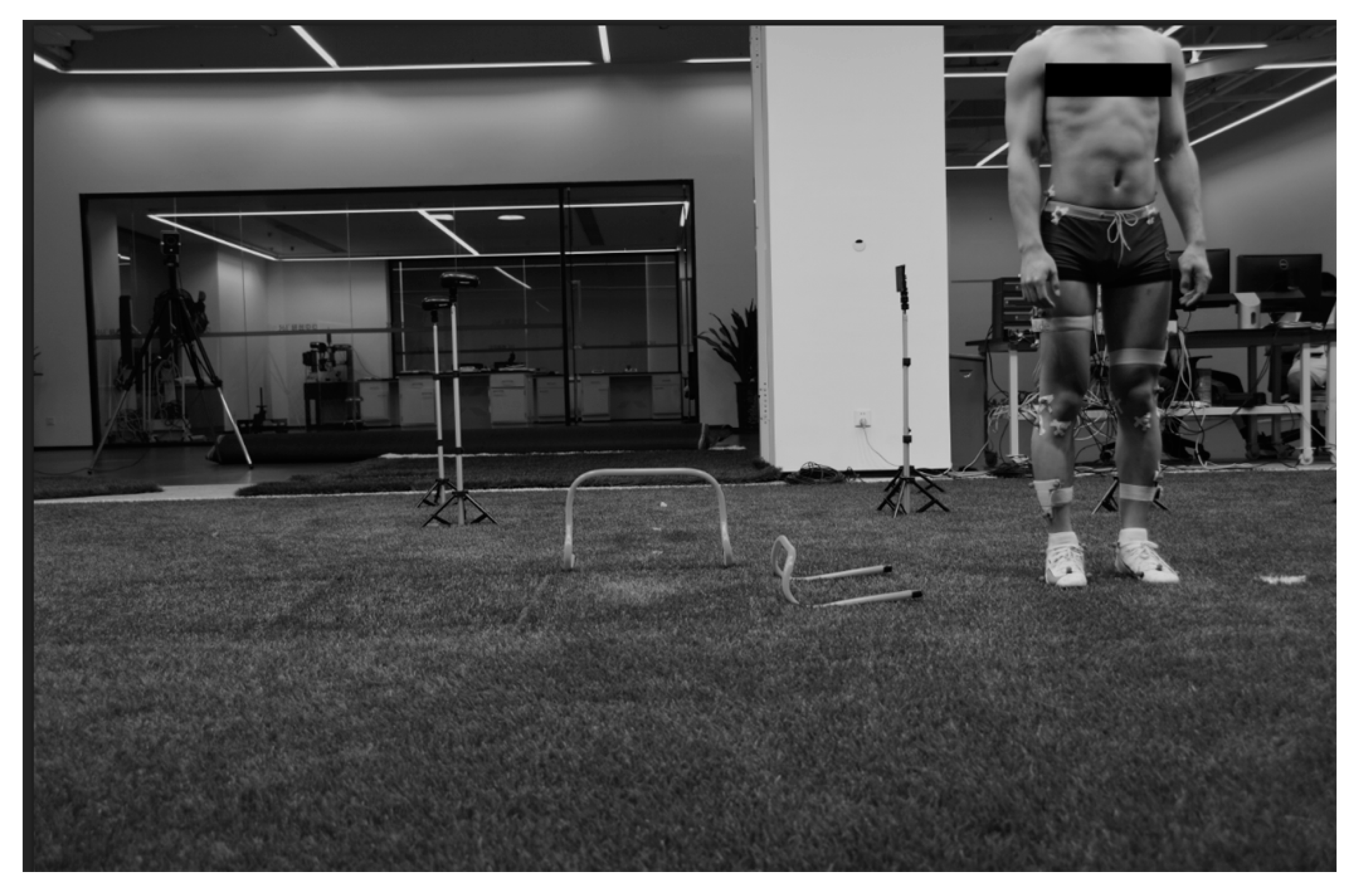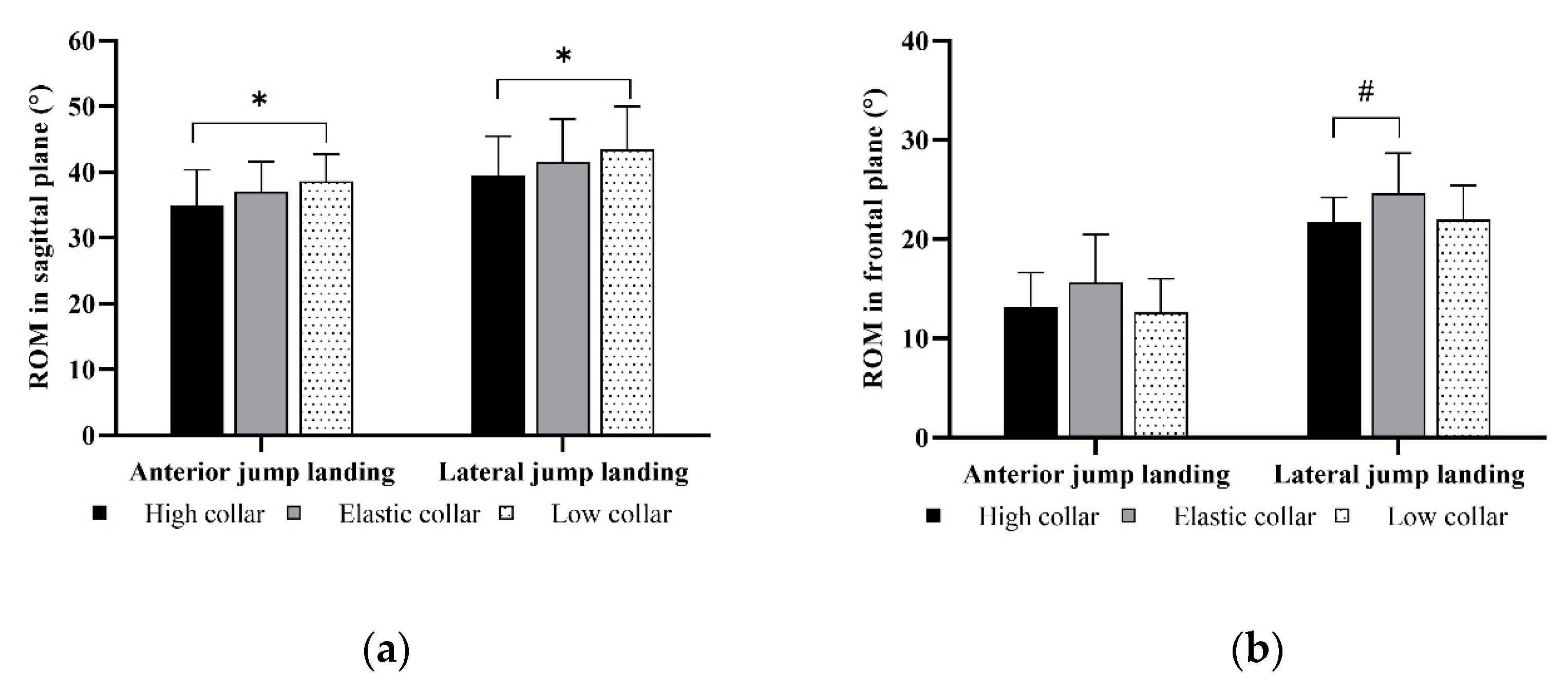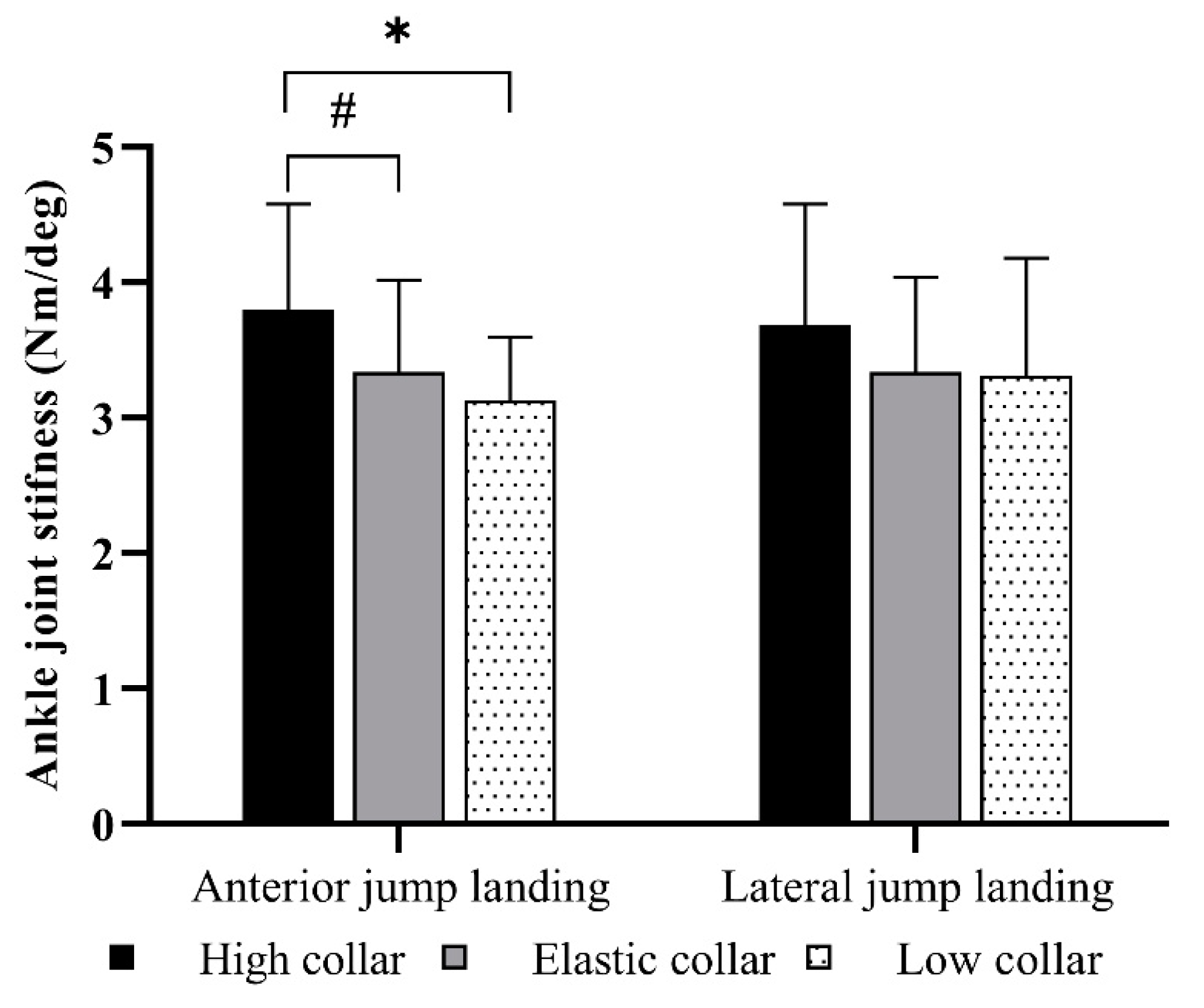Effect of Football Shoe Collar Type on Ankle Biomechanics and Dynamic Stability during Anterior and Lateral Single-Leg Jump Landings
Abstract
:1. Introduction
2. Materials and Methods
2.1. Participants
2.2. Equipment
2.3. Protocol
2.4. Data Analysis
2.5. Statistical Analyses
3. Results
3.1. Anterior Single-Leg Jump Landing
3.2. Lateral Single-Leg Jump Landing
4. Discussion
5. Conclusions
Author Contributions
Funding
Acknowledgments
Conflicts of Interest
References
- Walls, R.J.; Ross, K.A.; Fraser, E.J.; Hodgkins, C.W.; Smyth, N.A.; Egan, C.J.; Calder, J.; Kennedy, J.G. Football injuries of the ankle: A review of injury mechanisms, diagnosis and management. World J. Orthop. 2016, 7, 8–19. [Google Scholar] [CrossRef] [PubMed] [Green Version]
- Ekstrand, J. Epidemiology of football injuries. Lancet 2008, 23, 73–77. [Google Scholar] [CrossRef] [Green Version]
- Pfirrmann, D.; Herbst, M.; Ingelfinger, P.; Simon, P.; Tug, S. Analysis of injury incidences in male professional adult and elite youth soccer players: A systematic review. J. Athl. Train. 2016, 51, 410–424. [Google Scholar] [CrossRef] [PubMed] [Green Version]
- Wong, P.; Hong, Y. Soccer injury in the lower extremities. Br. J. Sports Med. 2005, 39, 473–482. [Google Scholar] [CrossRef]
- Hwang-Bo, K.; Joo, C.H. Analysis of injury incidences in the Korea national men’s soccer teams. J. Exerc. Rehabilit. 2019, 15, 861–866. [Google Scholar] [CrossRef]
- Dvorak, J.; Junge, A.; Derman, W.; Schwellnus, M. Injuries and illnesses of football players during the 2010 FIFA World Cup. Br. J. Sports Med. 2011, 45, 626–630. [Google Scholar] [CrossRef] [Green Version]
- Hertel, J.; Corbett, R.O. An updated model of chronic ankle instability. J. Athl. Train. 2019, 54, 572. [Google Scholar] [CrossRef] [Green Version]
- Torg, J.S.; Quedenfeld, T. Effect of shoe type and cleat length on incidence and severity of knee injuries among high school football players. Res. Q. 1971, 42, 203–211. [Google Scholar]
- Queen, R.M.; Charnock, B.L.; Garrett, W.E.; Hardaker, W.M.; Sims, E.L.; Moorman, C.T. A comparison of cleat types during two football-specific tasks on FieldTurf. Br. J. Sports Med. 2008, 42, 278–284. [Google Scholar] [CrossRef]
- Torg, J.S.; Stilwell, G.; Rogers, K. The effect of ambient temperature on the shoe-surface interface release coefficient. Am. J. Sports Med. 1996, 24, 79–82. [Google Scholar] [CrossRef]
- Liu, H.; Wu, Z.; Lam, W.K. Collar height and heel counter-stiffness for ankle stability and athletic performance in basketball. Res. Sports Med. 2017, 25, 209–218. [Google Scholar] [CrossRef] [PubMed]
- Lam, G.W.; Park, E.J.; Lee, K.K.; Cheung, J.T. Shoe collar height effect on athletic performance, ankle joint kinematics and kinetics during unanticipated maximum-effort side-cutting performance. J. Sports Sci. 2015, 33, 1738–1749. [Google Scholar] [CrossRef] [PubMed]
- Yang, Y.; Fang, Y.; Zhang, X.; He, J.; Fu, W. Does shoe collar height influence ankle joint kinematics and kinetics in sagittal plane maneuvers? J. Sports Sci. Med. 2017, 16, 543–550. [Google Scholar] [PubMed]
- Fu, W.; Fang, Y.; Liu, Y.; Hou, J. The effect of high-top and low-top shoes on ankle inversion kinematics and muscle activation in landing on a tilted surface. J. Foot Ankle Res. 2014, 7, 14. [Google Scholar] [CrossRef] [Green Version]
- Brizuela, G.; Llana, S.; Ferrandis, R.; Garcia-Belenguer, A.C. The influence of basketball shoes with increased ankle support on shock attenuation and performance in running and jumping. J. Sports Sci. 1997, 15, 505–515. [Google Scholar] [CrossRef]
- Thacker, S.B.; Stroup, D.F.; Branche, C.M.; Gilchrist, J.; Weitman, E.A. The prevention of ankle sprains in sports. a systematic review of the literature. Am. J. Sports Med. 1999, 27, 753–760. [Google Scholar] [CrossRef]
- Sherman, N.W.; Daniel, M. Effects of high-top and low-top shoes on ankle inversion. J. Phys. Educ. Recreat. Dance 2002, 73, 6. [Google Scholar] [CrossRef]
- Pizac, D.A.; Swanik, C.B.; Glutting, J.J.; Kaminski, T.W. Evaluating postural control and ankle laxity between taping and high-top cleats in high school football players. J. Sport Rehabilit. 2016, 27, 1–26. [Google Scholar] [CrossRef]
- Grimmer, K.; Williams, J. Injury in junior Australian Rules footballers. J. Sci. Med. Sport 2003, 6, 328–338. [Google Scholar] [CrossRef]
- Jones, D.; Louw, Q.; Grimmer, K. Recreational and sporting injury to the adolescent knee and ankle: Prevalence and causes. Aust. J. Physiother. 2000, 46, 179–188. [Google Scholar] [CrossRef] [Green Version]
- McGuine, T.A.; Greene, J.J.; Best, T.; Leverson, G. Balance as a predictor of ankle injuries in high school basketball players. Clin. J. Sport Med. 2000, 10, 239–244. [Google Scholar] [CrossRef] [PubMed]
- Willems, T.M.; Witvrouw, E.; Delbaere, K.; Mahieu, N.; De Bourdeaudhuij, I.; De Clercq, D. Intrinsic risk factors for inversion ankle sprains in male subjects: A prospective study. Am. J. Sports Med. 2005, 33, 415–423. [Google Scholar] [CrossRef] [PubMed]
- Lord, S.R.; Bashford, G.M.; Howland, A.; Munroe, B.J. Effects of shoe collar height and sole hardness on balance in older women. J. Am. Geriatr. Soc. 1999, 47, 681–684. [Google Scholar] [CrossRef] [PubMed]
- Simon, J.; Donahue, M. Effect of ankle taping or bracing on creating an increased sense of confidence, stability, and reassurance when performing a dynamic-balance task. J. Sport Rehabilit. 2013, 22, 229–233. [Google Scholar] [CrossRef] [PubMed]
- Fayson, S.D.; Needle, A.R.; Kaminski, T.W. The effects of ankle Kinesio taping on ankle stiffness and dynamic balance. Res. Sports Med. 2013, 21, 204–216. [Google Scholar] [CrossRef] [PubMed]
- Lee, B.G.; Lee, J.H. Immediate effects of ankle balance taping with kinesiology tape on the dynamic balance of young players with functional ankle instability. Technol. Health Care 2015, 23, 333–341. [Google Scholar] [CrossRef]
- Papadopoulos, E.S.; Nikolopoulos, C.S.; Athanasopoulos, S. The effect of different skin–ankle brace application pressures with and without shoes on single-limb balance, electromyographic activation onset and peroneal reaction time of lower limb muscles. Foot 2008, 18, 228–236. [Google Scholar] [CrossRef]
- Persson, U.M.; Arthurs, C. Dynamic postural stability in gaelic football players during a single leg drop-landing, a comparison of ankle tape and lace-up brace. Br. J. Sport Med. 2011, 45, 362. [Google Scholar] [CrossRef]
- Bowser, B.J.; Rose, W.C.; McGrath, R.; Salerno, J.; Wallace, J.; Davis, I.S. Effect of footwear on dynamic stability during single-leg jump landings. Int. J. Sports Med. 2017, 38, 481–486. [Google Scholar] [CrossRef]
- Wikstrom, E.A.; Tillman, M.D.; Smith, A.N.; Borsa, P.A. A new force-plate technology measure of dynamic postural stability: The dynamic postural stability index. J. Athl. Train 2005, 40, 305–309. [Google Scholar]
- Zhang, S.; Pan, J.; Li, L. Non-linear changes of lower extremity kinetics prior to gait transition. J. Biomech. 2018, 77, 48–54. [Google Scholar] [CrossRef] [PubMed]
- Pan, J.; Liu, C.; Zhang, S.; Li, L. Tai chi can improve postural stability as measured by resistance to perturbation related to upper limb movement among healthy older adults. Evid. Based Complement. Altern. 2016, 2016, 9710941. [Google Scholar] [CrossRef] [PubMed]
- Sell, T.C. An examination, correlation, and comparison of static and dynamic measures of postural stability in healthy, physically active adults. Phys. Ther. Sport 2012, 13, 80–86. [Google Scholar] [CrossRef] [PubMed]
- Williams, V.J.; Nagai, T.; Sell, T.C.; Abt, J.P.; Rowe, R.S.; McGrail, M.A.; Lephart, S.M. Prediction of dynamic postural stability during single-leg jump landings by ankle and knee flexibility and strength. J. Sport Rehabilit. 2016, 25, 266–272. [Google Scholar] [CrossRef] [PubMed] [Green Version]
- Farley, C.T.; Houdijk, H.H.P.; Ciska, V.S.; Ciska, V.S.; Micky, L. Mechanism of leg stiffness adjustment for hopping on surfaces of different stiffnesses. J. Appl. Physiol. 1998, 85, 1044–1055. [Google Scholar] [CrossRef]
- Wikstrom, E.A.; Tillman, M.D.; Borsa, P.A. Detection of dynamic stability deficits in subjects with functional ankle instability. Med. Sci. Sports Exerc. 2005, 37, 169–175. [Google Scholar] [CrossRef]
- Rowson, S.; McNally, C.; Duma, S.M. Can footwear affect achilles tendon loading? Clin. J. Sport Med. 2010, 20, 344–349. [Google Scholar] [CrossRef]
- Hamill, J.; Moses, M.; Seay, J. Lower extremity joint stiffness in runners with low back pain. Res. Sports Med. 2007, 17, 260–273. [Google Scholar] [CrossRef]
- Fong, C.M.; Blackburn, J.T.; Norcross, M.F.; McGrath, M.; Padua, D.A. Ankle-dorsiflexion range of motion and landing biomechanics. J. Athl. Train. 2011, 46, 5–10. [Google Scholar] [CrossRef] [Green Version]
- Debusk, H.; Hill, C.M.; Chander, H.; Knight, A.C.; Babski-Reeves, K. Influence of military workload and footwear on static and dynamic balance performance. Int. J. Ind. Ergonom. 2018, 64, 51–58. [Google Scholar] [CrossRef]




| Variables | Shoe Collar Condition | Pairwise Post Hoc | ||||
|---|---|---|---|---|---|---|
| High | Elastic | Low | H vs. E | H vs. L | E vs. L | |
| Anterior single-leg jump landing | ||||||
| Dorsiflexion ROM (°) * | 10.40 (5.19) | 12.83 (4.28) | 12.50 (4.16) | 0.031 (0.511) | 0.043 (0.446) | 0.718 (0.078) |
| Eversion ROM (°) | 10.47 (3.48) | 11.72 (3.43) | 10.09 (2.76) | 0.286 (0.362) | 0.691 (0.121) | 0.030 (0.524) |
| Peak plantarflexion moment (Nm/kg) | 2.38 (0.38) | 2.21 (0.36) | 2.24 (0.35) | 0.095 (0.459) | 0.789 (0.383) | 1.000 (0.084) |
| Peak inversion moment (Nm/kg) | 0.48 (0.24) | 0.58 (0.43) | 0.51 (0.31) | 0.442 (0.287) | 0.696 (0.108) | 0.437 (0.187) |
| Lateral single-leg jump landing | ||||||
| Dorsiflexion ROM (°) | 18.11 (5.13) | 20.50 (3.50) | 20.62 (2.39) | 0.058 (0.544) | 0.059 (0.627) | 0.907 (0.040) |
| Eversion ROM (°) | 8.85 (3.13) | 11.04 (4.29) | 9.20 (4.74) | 0.005 (0.583) | 0.752 (0.087) | 0.116 (0.407) |
| Inversion ROM (°) * | 12.10 (3.15) | 15.00 (5.88) | 12.97 (4.25) | 0.028 (0.615) | 0.323 (0.233) | 0.054 (0.396) |
| Peak plantarflexion moment (Nm/kg) | 2.42 (0.36) | 2.39 (0.49) | 2.51 (0.48) | 1.000 (0.070) | 1.000 (0.212) | 0.785 (0.247) |
| Peak inversion moment (Nm/kg) | 0.29 (0.21) | 0.37 (0.32) | 0.31 (0.21) | 0.402 (0.296) | 0.704 (0.095) | 0.496 (0.222) |
| Peak eversion moment (Nm/kg) | 0.35 (0.30) | 0.41 (0.26) | 0.38 (0.26) | 0.471 (0.214) | 0.689 (0.107) | 0.743 (0.115) |
| Variables | Shoe Collar Condition | Pairwise Post Hoc | ||||
|---|---|---|---|---|---|---|
| High | Elastic | Low | H vs. E | H vs. L | E vs. L | |
| Anterior single-leg jump landing | ||||||
| APSI | 0.17 (0.014) | 0.17 (0.022) | 0.17 (0.024) | 1.000 (0.101) | 1.000 (0.131) | 0.714 (0.194) |
| MLSI * | 0.039 (0.004) | 0.040 (0.007) | 0.045 (0.006) | 1.000 (0.204) | 0.001 (1.232) | 0.051 (0.116) |
| VSI | 0.42 (0.049) | 0.42 (0.050) | 0.43 (0.059) | 1.000 (0.035) | 0.387 (0.234) | 0.312 (0.263) |
| DPSI | 0.45 (0.045) | 0.45 (0.050) | 0.46 (0.058) | 1.000 (0.016) | 0.569 (0.220) | 0.526 (0.225) |
| Lateral single-leg jump landing | ||||||
| APSI | 0.064 (0.007) | 0.063 (0.007) | 0.063 (0.010) | 1.000 (0.116) | 1.000 (0.087) | 1.000 (0.007) |
| MLSI * | 0.14 (0.009) | 0.14 (0.009) | 0.14 (0.012) | 0.982 (0.203) | 0.359 (0.411) | 0.060 (0.588) |
| VSI | 0.39 (0.038) | 0.38 (0.049) | 0.38 (0.048) | 1.000 (0.078) | 1.000 (0.159) | 1.000 (0.071) |
| DPSI | 0.42 (0.038) | 0.41 (0.047) | 0.40 (0.060) | 1.000 (0.058) | 0.547 (0.340) | 0.614 (0.270) |
© 2020 by the authors. Licensee MDPI, Basel, Switzerland. This article is an open access article distributed under the terms and conditions of the Creative Commons Attribution (CC BY) license (http://creativecommons.org/licenses/by/4.0/).
Share and Cite
Tang, Y.; Wang, Z.; Zhang, Y.; Zhang, S.; Wei, S.; Pan, J.; Liu, Y. Effect of Football Shoe Collar Type on Ankle Biomechanics and Dynamic Stability during Anterior and Lateral Single-Leg Jump Landings. Appl. Sci. 2020, 10, 3362. https://doi.org/10.3390/app10103362
Tang Y, Wang Z, Zhang Y, Zhang S, Wei S, Pan J, Liu Y. Effect of Football Shoe Collar Type on Ankle Biomechanics and Dynamic Stability during Anterior and Lateral Single-Leg Jump Landings. Applied Sciences. 2020; 10(10):3362. https://doi.org/10.3390/app10103362
Chicago/Turabian StyleTang, Yunqi, Zhikang Wang, Yifan Zhang, Shuqi Zhang, Shutao Wei, Jiahao Pan, and Yu Liu. 2020. "Effect of Football Shoe Collar Type on Ankle Biomechanics and Dynamic Stability during Anterior and Lateral Single-Leg Jump Landings" Applied Sciences 10, no. 10: 3362. https://doi.org/10.3390/app10103362





